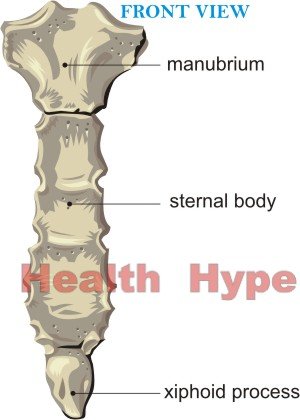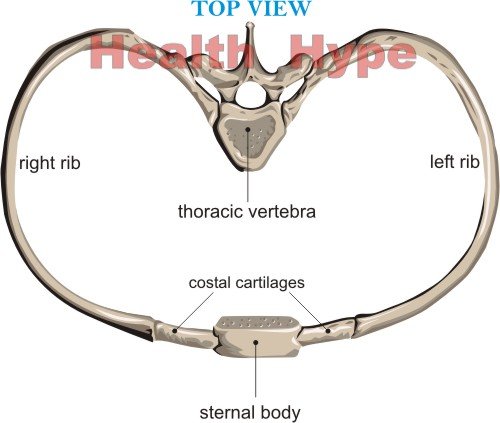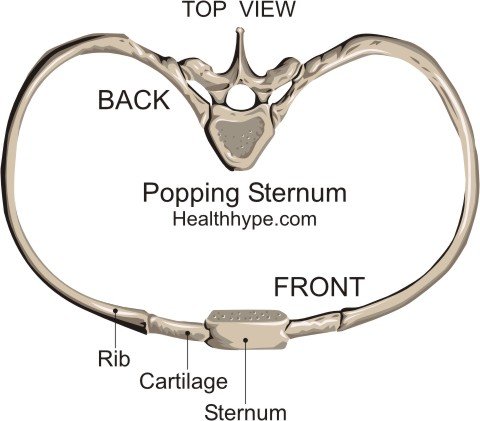Popping, Cracking, Clicking Sternum (Breastbone) Location and Causes
A popping or cracking noise emanating from the sternum (breastbone) is usually associated with the joints between the breastbone and ribs. These bones are connected to each other by a length of cartilage (costal cartilage) that extends from the rib and attaches to the sternum.
The cartilage of the first seven ribs articulate with the sternum at the sternocostal joints. These cartilages also articulate with the ribs at the costochondral joints. The clavicle also articulates with the sternum at the sternoclavicular joint although this is less likely to be associated with any audible clicking. The popping or cracking noise may be accompanied by breast bone pain, tenderness and/or joint swelling.
What is the sternum?
The sternum, commonly referred to as the breastbone, is a flat elongated bone at front of the chest. It is the bone to which the ribs attach to through the costal cartilages and the clavicle (collarbone) meets with at the sternoclavicular joint . The sternum is a natural ‘shield’ that protects the important organs in the thoracic cavity – the heart and great blood vessels. It has three parts known as the manubrium (top), body of the sternum (middle) and xiphoid process (bottom).
Anatomy of the Sternum
The sternum lies just under the skin and can be easily felt on the front of the chest. It is about 17 centimeters in length on average extending from just below the neck to the upper border of the abdomen. The sternum is usually longer in males than in females.
Parts of the Sternum
The three parts of the sternum are the :
- Manubrium
- Body
- Xiphoid Process
These three parts are joined by cartilaginous joints known as synchondroses right up through early adulthood. These types of joints offer very little mobility. By middle to late adulthood the joints ossify essentially making the sternum one continuous bone.
Manubrium
The manubrium is the uppermost and widest portion of the sternum. It is somewhat trapezoidal in shape and the thickest of the three bones that make up the sternum. The manubrium is approximately 4 centimeters long and lies at the levels of the T3 to T4 vertebrae. At the upper surface is a notch which can be easily felt over the skin. This is known as the jugular notch or suprasternal notch. On either side of the notch are two small clavicular notches where the clavicle (collarbone) meets the manubrium of the sternum to form the sternoclavicular joints or SC joints.
Just below these clavicular notches are the site where the first rib meets the outer (lateral) border of the manubrium through the costal cartilages at the first sternocostal joint. It differs from other sternocostal joints in that the costal cartilage is directly united with the sternum.The bottom of the manubrium forms a joint with the uppermost portion of the body of the sternum known as the manubriosternal joint. The manubrium and sternal body lies in slightly different planes forming an angle known as the sternal angle or angle of Louis.
Body of Sternum
The body of the sternum or sternal body is the longest part of the three bones. It is approximately 10 centimeters in length lying between the T5 and T9 vertebrae. There are four segments of the body known as the sternebrae which articulate with each other at cartilaginous joints similar to that between the manubrium and sternal body (manubriosternal joint). Around the mid 20’s these joints begin to fuse leaving only three transverse ridges visible on the sternal body. These joints between the sternebrae are known as the sternal synchondroses.
The sternal body is thinner than the manubrium. It has four depressions (facets) on its side to house the costal cartialges of the third, fourth, fifth, sixth and seventh ribs. The second rib is attached to the sternum at the junction of the manubrium and sternal body. The bottom of the manubrium has a small facet which is continuous with a small facet at the top of the sternal body to accommodate the costal cartilage of the second rib.
The first to seventh ribs are referred to as true ribs because it has its own costal cartilage which connects it to the sternum. The eighth, ninth and tenth ribs communicate with the sternum through the costal cartilages of the ribs above it and are therefore known as false ribs. The lower part of the sternal body meets with the xiphoid process at the xiphisternal joint.
Xiphoid Process
The xiphoid process is the bottom part of the sternum. It is thin and elongated and varies somewhat in shape sometimes having a pointed tip while at other times the tip is blunt and rounded. The xiphoid process is mainly cartilage in young children but gradually ossifies to become bone after the age of 40. Sometimes the xiphoid process fuses with the sternal body in the elderly.
Location of the Sternum
The sternum is located at the middle of the front part of the rib cage between the breasts. In women, the cleavage of the breasts (intramammary cleft) lies over the sternum. The location of the sternum has therefore contributed to the common term breastbone although it it not part of the male or female breast. Anatomically the sternum extends from the level of the third to about the the tenth thoracic vertebrae although this may differ due to the highly variable length and shape of the xiphoid process. The sternum is an important anatomical landmark in medicine and understanding the location of other organs in relation to it is therefore important.
Behind the sternum
- Left side of manubrium- arch of the aorta
- Right side of manubrium – brachiocephalic veins merge to form the superior vena cava (SVC)
- Upper half of the sternal body – part of the right atrium, ascending aorta and pulmonary trunk (artery)
- Lower part of the sternal body – right ventricle and inferior vena cava (IVC)
- Xiphisternal joint – central part of the diaphragm
- Xiphoid process – superior surface of the liver
These organs and structures behind the sternum are important considerations in conditions such as breastbone pain.
Video of Sternum
The following video on the sternum and breastbone pain was produced by the Health Hype team.
Why do the sternal joints click?
The exact mechanism of popping or cracking of any joint is not known. It may be due to the ‘snapping’ of ligaments or tendons, gas bubbles released from the joint fluid (cavitation) or partial dislocation (sublaxation). At times a grating noise may be heard, like two rough surfaces scraping against each other. This may occur if there is erosion of the bone or joint lining which occurs as a consequence of certain types of arthritis that persist over a long period of time.
Popping joints are not usually considered to be a medical problem unless there is pain, swelling or limited mobility associated with the cracking or clicking. In these cases, inflammation of the joint is likely and the popping noise may settle, along with the pain and swelling, over time or with the use of anti-inflammatory drugs.
The popping may occur spontaneously but usually occurs with movement like when breathing deeply or stretching the arms wide. The popping may sometimes relieve the pain, if present. In some cases, stress may aggravate the popping sound and breast bone pain.
Causes of Popping, Cracking Sternum or Ribs
Some of the causes of the clicking of the sternum or rib may include :
- Trauma. Injury to the chest area, example – assault, falls or car accident injuries where there is impact with the steering wheel.
- Physical strain. This may be seen in excessive weight lifting (bench pressing) or other activities that put pressure on the chest wall, its muscles and bones. A person who supports their body weight on one hand or elbow over long periods may transfer the weight across the costal cartilage and thereby strain the joint possibly leading to inflammation or sublaxation.
- Costochondritis is the inflammation of the costal cartilage and usually affects the fourth to sixth ribs. This may be caused by infections, postoperatively (like in cardiothoracic ‘open heart’ surgery) or after repeated minor trauma and/or physical strain. Pain and tenderness is usually present although swelling is not typically evident.
- Tietze’s syndrome is similar to costochondritis but usually affects the second and third ribs and more commonly occurs in young girls. Apart from pain, there is also detectable swelling. It is usually caused by the repeated minor trauma or physical strain, including persistent coughing or repeated vomiting.
- Muscle spasm may also cause sublaxation of the joint as the degree of flexibility is limited due to ‘tight’ muscles. This is usually accompanied by chest pain. Refer to the article on Muscle Chest Pain.
- Osteoarthritis or rheumatoid arthritis. These types of arthritis do not commonly affect these joints or cause clicking but it may be possible in widespread cases of arthritis. Joint degeneration due to chronic arthritis could cause a grating sound.
- Calcification of the costal cartilage.
References
- Sternum area anatomy. Health Line
- Mediastinitis. Medscape
Last updated on August 19, 2018.








